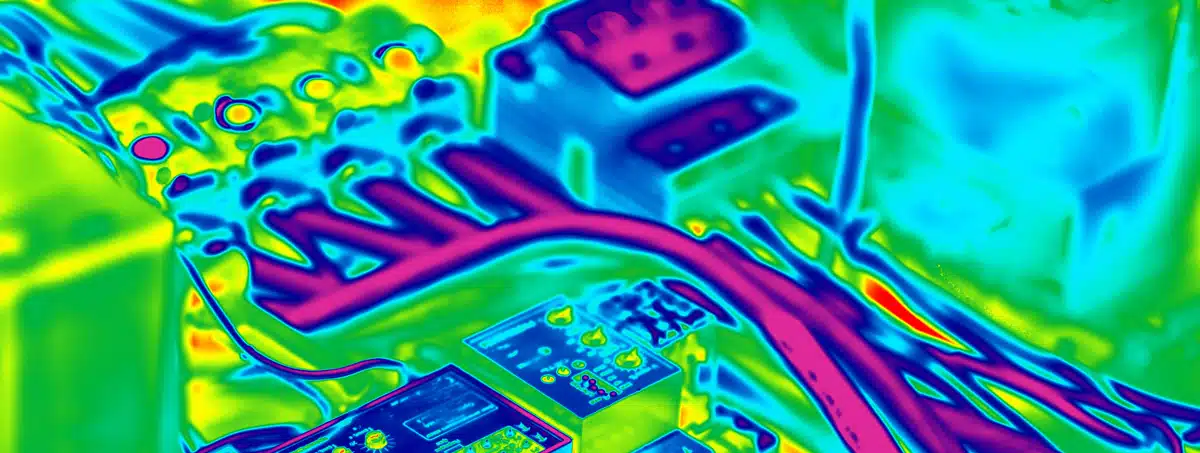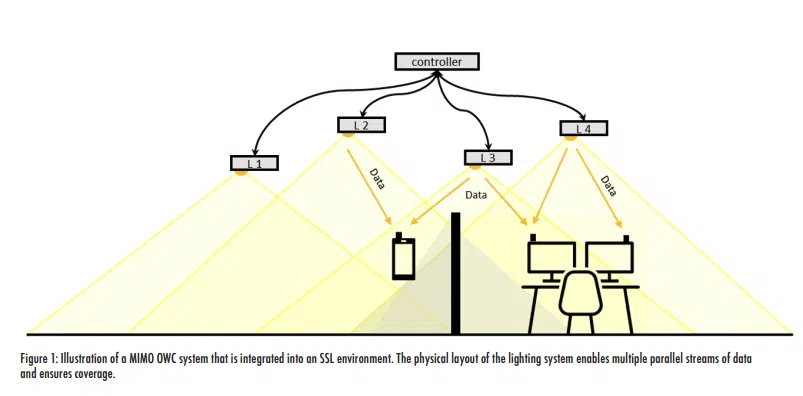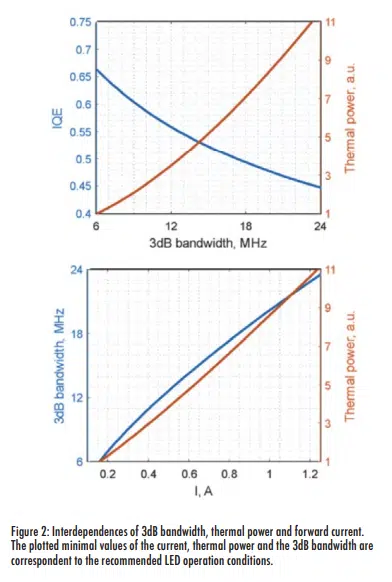The rapid increase of device connectivity, coupled with constantly growing data transmission rates, increases the demand for new communication channels. Illumination systems employing Light Emitting Diodes (LEDs) have the potential to fulfill this demand. LEDs are versatile components that are used as a light source in a vast number of products: indoor and outdoor lighting, traffic signs, vehicle lights, displays, projectors, etc. At the same time, LEDs have an outstanding potential for data transmission due to their fast on- and off-switching times. Attempts to further accelerate their response is a topic of current study. This paper theoretically analyzes opportunities to increase the bandwidth to enhance data transmission rates by increasing the current density. The associated thermal penalties are estimated.
Introduction
A major trend in wireless communication is the continuously increasing carrier frequency. The increase of the carrier frequency enables the exploitation of a wider range of the spectrum and allows wider modulation bandwidths. At the same time, we see an intentional shrinking of the communication network’s cell size. This enables denser reuse of the same spectrum. At low subscriber density, systems are optimized for range and coverage, which favors radio frequency (RF). With increasing user density and saturation of the spectrum, reuse and density requirements prevail. The latter favors communication by light, referred to as optical wireless communication (OWC) or LiFi [1]. The ITU g.hn g9991 standard proves to be viable in products from multiple vendors [2].
The trend of shrinking cell sizes and the demand for low-latency communication, free of jitter from contending traffic, is well addressed by natural barriers such as walls, that allow full reuse of the light spectrum in separate rooms. The trend of moving to higher frequencies, i.e. shorter wavelengths, also makes a transition to OWC plausible.
While OWC may be vulnerable to blockage of line-of-sight propagation, distributed-multiple-input multiple-output (D-MIMO) systems with spatially separated light sources in the ceiling can provide high robustness [3]. MIMO can provide a high-bandwidth and stable connection to numerous users in crowded environments, much like the seamless shadow-free illumination that lighting systems provide.
Moreover, Li-Fi systems can reuse the light of Solid-State Lighting (SSL) LED illumination, as shown in Figure 1. Indeed, the SSL infrastructure is a perfect candidate for augmentation with the OWC functionality. Lighting systems are designed to illuminate the entire environment to ensure a contiguous coverage from multiple angles. However, white illumination LEDs are optimized for (DC) illumination. Thus, they are designed for high efficiency without considering a potential need for high modulation bandwidth. Therefore, it is beneficial it turns out to be attractive to included additional light sources, in particular infra-red LEDs, to carry data [3].
The performance of the OWC channel is limited by the modulation bandwidth that is linked to the 3dB bandwidth of the LEDs [4]. By appropriately choosing LED operational parameters, the 3dB bandwidth can be enlarged. One of the possible ways to increase it is to increase the current density flowing through the pn-junction. Such an approach is common for micro-LEDs. The data transmission rates through larger LEDs can also be boosted using a similar approach. However, there is a major thermal penalty. Higher current flowing through the pn-junction affects the LED in two major ways. Firstly, it directly contributes to heat generation. Secondly, it decreases the Internal Quantum Efficiency (IQE), which leads to a higher fraction of the electrical power applied to the LED being dissipated as heat. These two reinforcing factors lead to a temperature rise of the LED package, unless they are mitigated with proper thermal management. Otherwise, the LED may not only perform less effectively but may also have a reduced lifetime or may even experience a catastrophic failure. This paper presents a theoretical analysis of this additional thermal penalty. The analysis is based on the investigation of the theoretical IQE dependence on the bias current. The IQE dependence is considered within a framework of ABC recombination model [5,6].
Dependence of the LED modulation frequency and heat dissipation on the bias current
The Multiple Quantum Well (MQW) architecture is now commonly used for highly efficient LEDs used in the illumination market. The quantum wells create narrow regions with a high concentration of holes and electrons. This facilitates the recombination processes by increasing the chance that an electron and a hole are in the same spatial region. Indeed, radiative recombination requires these two particles to be in the vicinity of each other to recombine and emit a photon. In our calculations, we model the MQW structure as a single quantum well and assume a uniform spatial density of electrons and holes inside of it. Thus, the radiative recombination rate can be modeled as a product of the second order of the MQW carrier concentration, N, and a pn-junction design-dependent constant, i.e., ~BN2 . The radiative recombination rate is proportional to the light flux. However, it is not the only recombination mechanism that takes place in the LED. It competes with the parasitic Shockley-Read-Hall and Auger recombination channels. The recombination rates of these channels are proportional to the first and the third orders of the quantum well carrier density multiplied by the corresponding material and design-dependent constants. The Shockley-Read-Hall recombination rate is proportional to ~AN and the Auger recombination rate is proportional to ~CN3 . Often carrier leakage and other recombination channels are incorporated into a fourth-order term ~DN4 [7]. The fourth-order term allows better fitting of the LEDs efficiency curves at the high bias current densities.
In steady state, the total current I, flowing through an LED, can be expressed as the product of the total recombination rate and the elementary charge q:
The Internal Quantum Efficiency IQE of an LED is defined by the ratio of the radiative recombination rate to the total recombination:
Here, we divided out one order of N in both the enumerator and denominator. As can be seen in the previous two equations, the LED efficiency depends on the carrier concentration in the QW, which is determined by the injection current. The carrier differential lifetime τ defines the characteristic response time to a small-signal modulation. Within the ABC model framework, it is defined as [8]:
In the small-signal approximation, the 3dB bandwidth of the LED is proportional to the reciprocal of the differential carrier lifetime and can be expressed as:
We see that the 3dB bandwidth depends on the carrier concentration, which in turn depends on the bias current. Therefore, the bias current directly affects the maximal modulation frequency and can be used as a knob to tweak it. Thus, the IQE, and therefore the thermal power dissipated by the LED, are also dependent on the bias current.
The thermal power dissipated by an LED can be modeled as a function of the forward voltage V, current I, IQE, and Light Extraction Efficiency LEE of the LED package:
In other words, any electrical power that is not converted into light is dissipated as heat. In our calculations, we assume a zero parasitic series resistance and a weak dependence of the forward voltage on the forward current at bias conditions above the nominal operating point, i.e., V is reasonably constant. We also assume that the LEE is constant and equal to 85%, which is a typical value for high-brightness LED packages [9].
We use the ABCD parameters of a typical commercial illumination GaN LED. The parameters were estimated and validated in [10]. We calculate the theoretical inter-dependences of Pth, IQE and f3dB. We express the thermal power in arbitrary units for ease of interpretation.
Discussion
Data in Figure 2 illustrate the characteristic dependencies of the crucial design parameters for LEDs used in SSL systems with OWC functions. We see that a bandwidth increase is possible via an increase in the bias current. Yet, this results in thermal dissipation and efficiency penalties. A twofold increase of the 3dB bandwidth from 6 MHz to 12 MHz leads to at least a threefold increase in thermal dissipation and a considerable efficiency reduction.
This demonstrates the feasibility of creating SSL luminare designs with tunable OWC properties. Such a luminare can provide both increased data rates and can retain high efficiency when it is not used for OWC. The luminaire design may incorporate multiple sets of LEDs with at least two modes of operation. In the illumination mode, the luminaire uses all the LEDs to maximize lighting efficiency. In the high-speed data transmission mode, a part of the LEDs switches off. The brightness decrease is compensated by the additional current supplied to the remaining operational LEDs. This boosts the bandwidth and therefore the data rate through these LEDs. Nevertheless, the overall efficiency of the luminare does decrease in this second mode.
Our analysis may underestimate the thermal effects and, in practice, the thermal penalty may be even higher. Specifically, our analysis assumed perfect heat sinking and ignored the fact that an increase in junction temperature causes thermal droop. One can estimate the additional drop in efficiency with observations reported in [11]. This drop is relevant to miniaturized systems with inadequate active thermal management that may not be able to cope with an increased thermal load and may not keep the LED junction temperature sufficiently low to avoid thermal droop.
Conclusions
We theoretically analyzed bandwidth tuning for accelerating data transmission in solid-state lighting systems, based on models and measurements in earlier work. The results demonstrated the feasibility of creating SSL systems with tunable efficiency and bandwidth. Nevertheless, this design may require advanced thermal management solutions to handle the additional thermal load caused by the increasing bias current at a high-speed data transmission mode. The thermal management solutions are dependent on luminaire design and may include replacing thermal plastic heat sinks with metal ones or even introducing active cooling. Finally, we have shown that the required current increase may significantly decrease the efficiency of an SSL system in this mode.
References
[1] H. Haas et al., “What Is Lifi?,” J. Lightwave Tech., vol. 34, no. 6, 2015, p. 1533–44.
[2] A.M. Khalid et al., “Productization Experiences of G.vlc (ITU) based LiFi System for High Speed Indoor Wireless Access”, Optical Wireless Communication Conference (OWCC), 2020
[3] S. M. Kouhini, S. M. Mana, R. Freund, V. Jungnickel, C. R. B. Correa, E. Tangdiongga, T. Cunha, Xiong Deng, Jean-Paul M. G. Linnartz, “Distributed MIMO Experiment Using LiFi Over Plastic Optical Fiber”, IEEE Global Communications Conference (GLOBECOM), 2020
[4] J. P. M. G. Linnartz, X. Deng, A. Alexeev, and S. Mardanikorani, “Wireless communication over an led channel,” IEEE Commun. Mag., vol. 58, no. 12, 202, p. 77–82
[5] J. Cho, E. F. Schubert, and J. K. Kim, “Efficiency Droop in Light-Emitting Diodes: Challenges and Countermeasures,” Laser & Photonics Reviews, vol. 7, no. 3, 2013, p. 408–21.
[6] Q. Dai et al., “On the Symmetry of Efficiency-Versus-Carrier concentration Curves in GaInN/GAN Light-Emitting Diodes and Relation to Droop-Causing Mechanisms,” Applied Physics Letters, vol. 98, no. 3, 2011, p. 033506.
[7] M. A. Hopkins, D. W. Allsopp, M. J. Kappers, R. A. Oliver, and C. J. Humphreys, “The ABC model of recombination reinterpreted: impact on understanding carrier transport and efficiency droop in InGaN/GaN light emitting diodes,” J. Appl. Phys. 122, 2017, p. 234505
[8] A. David et al., “Carrier Dynamics and Coulomb-Enhanced Capture in III-Nitride Quantum Heterostructures,” Applied Physics Letters, vol. 109, no. 3, 2016, p. 033504.
[9] T.-p. Chen, et al., “Improvement in light extraction efficiency of high brightness InGaN-based light emitting diodes,” Proceedings of SPIE – The International Society for Optical Engineering, vol. 7216, (2009) p. 72161T
[10] A. Alexeev, et al., “Characterization of dynamic distortion in LED light output for optical wireless communications”, Photon. Res., vol. 9, no. 6, 2021, p. 916
[11] I.E. Titkov et al., “Temperature-dependent internal quantum efficiency of blue high-brightness light-emitting diodes.” IEEE J. Quantum Electron 50, 2014, p. 911–920.











